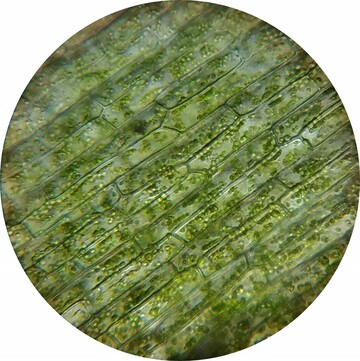What are the similarities and differences between plant and animal cells?

Plant cells have distinct features visible under a microscope.

Plant cells have distinct features visible under a microscope.
Both plant and animal cells have a cell membrane, which is a thin layer that surrounds the cell and protects it. They also both have a nucleus, which is the control center of the cell and contains the cell's DNA. Additionally, both plant and animal cells have ribosomes, which are small structures that make proteins. Finally, both plant and animal cells have mitochondria, which are the cells' power plants.
However, there are also some key differences between plant and animal cells. Plant cells have a cell wall, which is a rigid layer that surrounds the cell membrane and gives the plant cell its shape. Animal cells do not have a cell wall. Plant cells also have chloroplasts, which are organelles that use sunlight to make food for the plant. Animal cells do not have chloroplasts. Finally, plant cells have a large central vacuole, which is a space filled with water. Animal cells have smaller vacuoles.
Here are some examples of how plant and animal cells are different:
- If you were to look at a piece of lettuce under a microscope, you would see that the cells are rectangular in shape. This is because plant cells have a cell wall, which gives them their shape. Animal cells, on the other hand, do not have a cell wall, so they are more round or irregular in shape.
- If you were to look at a slice of onion under a microscope, you would see that some of the cells have green blobs inside them. These are chloroplasts, which are organelles that help plants to make food. Animal cells do not have chloroplasts, so they cannot make their own food.
Plant and animal cells are both very important, and they have many similarities. However, there are also some key differences between them, such as the presence of a cell wall and chloroplasts in plant cells. These differences help each type of cell to perform its own special functions.
How do plants and animals interact within ecosystems?
Plants and animals have a special relationship in ecosystems. Plants provide food and shelter for animals, and animals help plants to spread their seeds. Let's take a look at an example in a forest. The tall trees in the forest provide a home and protection for birds. The birds eat insects that could harm the trees, helping to keep them healthy. In return, the trees provide the birds with a safe place to live and build their nests. This is just one example of how plants and animals work together in an ecosystem.
How do animals rely on plants for food?
Many animals rely on plants for their food. They eat the leaves, fruits, seeds, or even the whole plant itself. For instance, squirrels love to munch on acorns from oak trees. They eat the acorns for energy and to grow strong. In the same way, rabbits eat grass and carrots to get the nutrients they need to survive. Animals and plants depend on each other for survival in an ecosystem.
How do plants benefit from animals?
Plants also depend on animals to help them reproduce and spread their seeds. Let's imagine a bumblebee buzzing around a beautiful flower. While collecting sweet nectar from the flower, the bee gets pollen on its body. When the bee visits another flower of the same kind, some of the pollen rubs off and fertilizes the flower, helping it to make seeds. This is called pollination, and it's an important way for plants to reproduce. Animals like bees, butterflies, and birds help plants by spreading their pollen from flower to flower.
How do plants and animals communicate with each other?
Plants and animals don't communicate in the same way that we do with words, but they can send signals to each other. For example, some plants release scents or produce bright flowers to attract pollinators, like bees or butterflies. The colors and smells let the animals know that the plants have tasty nectar to offer. Similarly, animals can leave their scent marks on trees or plants to send messages to other animals. These signals help plants and animals find each other and work together.
How do plants and animals rely on each other for shelter?
Plants provide animals with shelter and protection in different ways. Trees, for example, offer a cozy place for birds to build their nests high up in the branches. The tree's leaves also provide shade for animals to escape from the hot sun. On the other hand, animals help plants by spreading their seeds to new places. Some animals, like squirrels, bury nuts underground and forget where they hid them. When these animals don't find their hidden food, the seeds that they buried can grow into new plants. This way, plants get help to spread and grow in different areas of the ecosystem.
How do plants and animals rely on each other for oxygen?
Plants and animals have a unique connection when it comes to oxygen. During a process called photosynthesis, plants use sunlight, water, and carbon dioxide to make their own food and release oxygen as a byproduct. This oxygen is what animals need to breathe and survive! So, plants provide us with fresh oxygen to breathe, and in return, animals release carbon dioxide during respiration, which plants use to make more food. It's like a wonderful cycle of giving and receiving between plants and animals.

Plant cells have distinct features visible under a microscope.